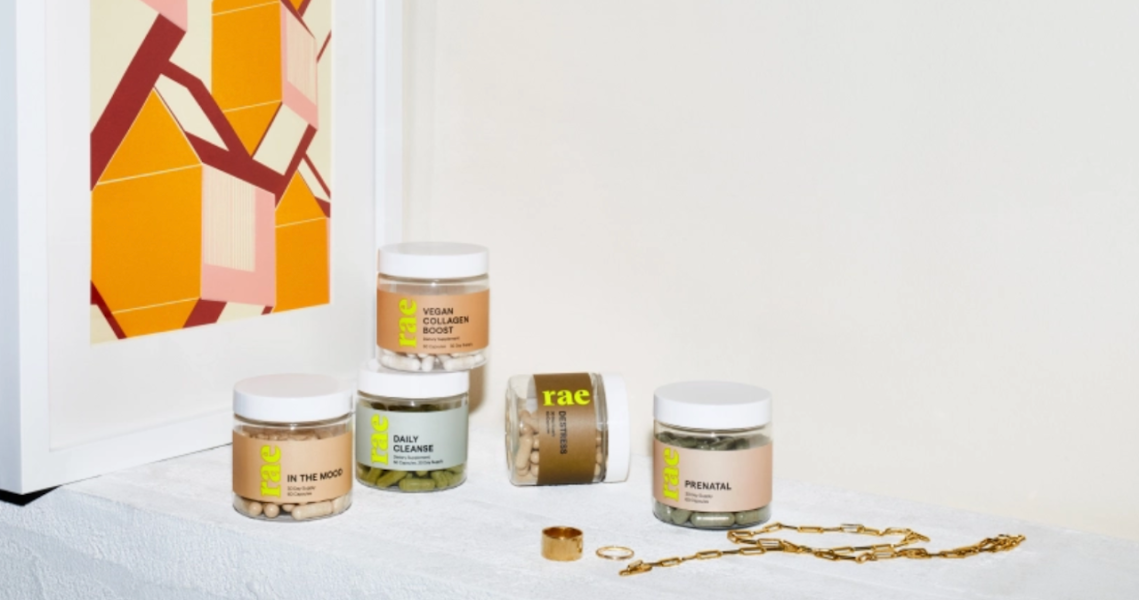This story was originally published in Modern Retail, our sibling publication.
Direct-to-consumer supplement brand Rae Wellness may have only been around since 2019, but the company’s products can already be found at thousands of brick-and-mortar stores.
In total, Rae Wellness products can be found at 7,500 physical stores nationwide. Just months after the brand launched, it formed an exclusive partnership with Target. And now this month, Rae products — including its Daily Cleanse Capsules, Destress Capsules and Sleep Capsules — are now available at Walmart stores and Walmart.com. Rae Wellness is also found through e-commerce channels like Amazon and Thrive Market, as well as through its own website.
Rae Wellness was co-founded by Angie Tebbe, a Target alum who has held various senior roles at the company specializing in private labels. Tebbe said being in brick-and-mortar stores had always been a major component of the company’s growth roadmap because it makes Rae products more accessible. She said digital and physical channels each make up 50% of Rae’s sales.
“I knew that 80-plus percent of purchases happen at physical retail,” Tebbe said. “If you look at the U.S. population, about 40% of people make a purchase every single week at a physical store, at least once a week.”
The brand has captured 2 million unique customers in its first two years, with more than one unit being sold for every customer. Rae declined to share its revenue figures but has raised $9.5 million in a Series A funding round announced last year. Rae products can also be found in Whole Foods, CVS Pharmacy and Anthropologie, among others.
Its most recent partnership with Walmart stems from the big-box retailers’ large physical footprint and close proximity to many consumers, Tebbe said. Rae Wellness offers 22 products in total, with items focusing on stress, digestion and skin, among others. Its capsules and drops each cost around $14.99 a bottle.
Ad position: web_incontent_pos1
“What I learned across my entire career is one, you have to start with a consumer – who are they, where they shop, how will they buy,” Tebbe said. “That led to our omnichannel business model, and we knew that we wanted to go after a younger, more diverse consumer.”
When making decisions the company tends to consider both physical and digital channels, Tebbe said. For example, Rae’s packaging is designed to grab people’s eyes as it sits on shelves, but it is also designed to be Instagramable or postable. The company has a sizable social media audience, with over 170,000 followers on TikTok and nearly 50,000 on Instagram.
Several DTC wellness brands have also made their way into physical retail stores. Target, for instance, has added DTC brands like vitamin brand Care/of, supplement gummies Sugarbreak and feminine care brand Proof. Meanwhile, Walmart has inked deals with sexual wellness brands Lola and Modern Fertility.
Dan McCarthy, assistant professor at Emory University’s Business School, said brands can only grow so much if they remain a purely digital player. Alternative sources of distribution like physical stores allow brands to drive more sales and acquire more consumers.
“The fundamental constraint that they often bump up against is that there’s only so many people that they can reach through the website, through Facebook ads and other forms of paid media,” McCarthy said. “Stores can be potentially a very effective way of being able to generate awareness from groups of people who otherwise would not have been aware of the brand.”
Ad position: web_incontent_pos2
For physical retailers, on the other hand, partnering with DTC brands allows them to introduce a degree of freshness to their stores, said Ethan Chernofsky, vp of marketing at Placer.ai.
“It’s exciting and interesting and new. It allows [physical retailers] to create excitement within stores,” Chernofsky said. “But there’s also another element that I think is a big piece of it, and it’s the ability to target different audiences and bring the right audiences into stores.”
While there are plenty of opportunities associated with building a physical presence, experts said there are also costs involved with distributing to different channels. Additionally, experts said the skills needed to be a successful DTC brand aren’t the same skills required to successfully operate a portfolio of stores such as staff management and site selection.
As the company continues to grow, Tebbe said it is hard to say whether the companies’ sales from digital and physical retail maintain the same even split. Rae will be available in 4,000 Walmart stores, which Tebbe said could change the balance of the business.
“Our focus is to grow all of our incumbent channels,” Tebbe said.“The goal is that this brings an incremental audience that buys that category at that retailer and kind of grows their total pie as a company.”




